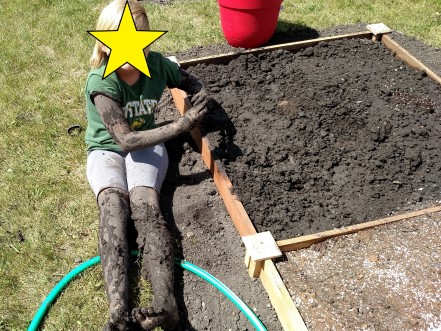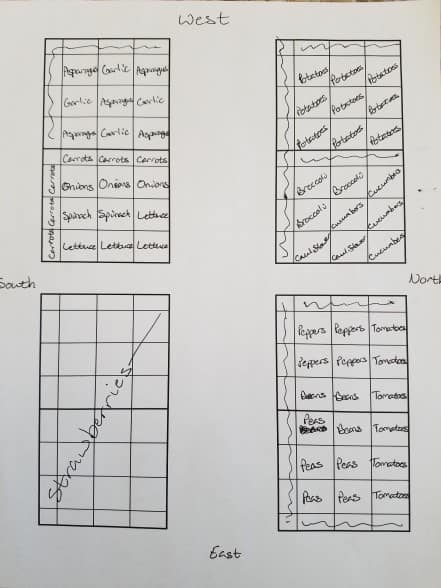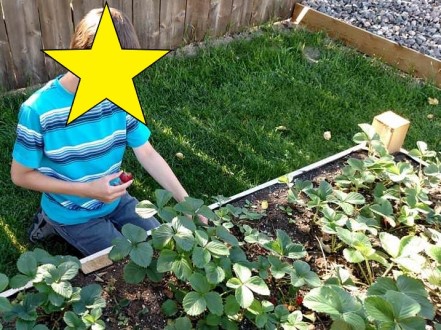If you’re new to gardening or have a limited amount of space, square foot gardening is a good way to start. Since it is a small space, high yield, type of gardening, you can get a lot of produce out of a small area.

It’s also easy to start with if you do it in a raised bed. Minimal digging in the yard and the border is clearly defined. Though it is a fairly easy method of gardening, there are mistakes that can be made. Read about my biggest mistake here.
What is square foot gardening?
This post may contain affiliate links. That means if you click on them and buy something, I may receive a small commission. Read my Disclaimer Policy to learn more. As an Amazon Associate, I earn from qualifying purchases.
Square foot gardening is a way of gardening that produces a high yield, in a small, ordered area. It is typically done in a raised bed that is most often 4 ft by 4 ft or 4 ft by 8 ft.
The garden bed, whether raised or not, is then divided into squares that are 1 ft on each side, for a total of 1 square foot per section.
You also do not put any room for walking in the bed which saves space in your yard and keeps the soil from getting compacted.
You can read more about square foot gardening from the creator of this method, Mel Bartholomew in his book All New Square Foot Gardening.
How do you square foot garden?
First, you start off by making your garden bed. I prefer using raised beds because it allows me to adjust the soil more easily. Where I live the soil is largely clay which makes it difficult to plant in. It is rich in nutrients but almost impossible to dig with a little hand shovel.
I purchased my raised beds at Walmart, they are 3 ½ by 3 ½ beds made out of cedar boards that can be combined into larger beds. You can also make your own out of cedar boards.
I recommend cedar because it will last longer than untreated pine boards. Treated wood is not recommended as the chemicals that were used to treat it may leech out of the wood and into your plants and into what you will be eating.
The most common size of raised bed it 4 ft by 4 ft, but any size that works for you is fine. Just make sure you can reach all areas of the bed from the edges.
Once your bed is made you need to fill it with soil. We usually use a combination of peat moss, compost, and garden soil. I believe it’s 1 bag of peat moss for 2 bags of garden soil and 1 of compost. A lot depends on how big of an area you have to fill.
If you have kids that enjoy playing in the dirt, this is a good job for them to help with. Hubby had our youngest, CJ, help him fill our beds when we put them in. As you can see in the picture below, she loved helping and playing in the dirt.

Last year I discovered a new type of soil replacement, coconut coir. It’s supposed to be a substitute to peat moss and is much better on the environment since it is just the outside of a coconut that would be wasted otherwise.
I tried it as a soil replacement, since you can do that with peat moss, and I would not recommend that. It stayed much to wet to be used as soil replacement, but it was a great additive to other potting soil.
I would definitely try it again as a soil additive in my garden or to use in pots as a way to keep in the moisture. I just wouldn’t recommend using more than 25 to 50 percent coconut coir for your planting.
Garden is prepared, now what?
Once the garden bed is made, it’s time to plant it. The first thing you need to do is decide what you want to plant. Think about what your family likes to eat and go from there. Or add in something new.
If you have kids, having them help at this stage and beyond may increase the chances that they will eat it. Some kids are more likely to eat a vegetable if they helped grow it.

One thing to remember is that some plants can be grown closer together than others. This means you can plant more of one type of crop in a square foot than other crops. Keep that in mind while deciding on what to plant.
How Much to Plant Per Square Foot
If your curious, this is my garden plan for one year. I do try to rotate some crops from year to year to prevent bugs, or because I had bugs one year that will survive our ND winters in the ground.

1 plant per 2 square feet
- Melon
- Pumpkin
- Summer Squash
- Winter Squash
- Zucchini
1 plant per square foot
- Asparagus (perennial)
- Basil
- Broccoli
- Cabbage
- Cauliflower
- Cucumbers
- Eggplant
- Oregano
- Peppers
- Potatoes
- Tomato
- Sunflower
2 plants per square foot
- Celery
- Kale
4 plants per square foot
- Corn
- Garlic
- Head Lettuce
- Marigold
- Romaine Lettuce
- Strawberries (perennial)
- Thyme
8 plants per square foot (on a trellis)
- Peas
- Pole Beans
9 plants per square foot
- Beets
- Bush Beans
- Cilantro
- Dill
- Leeks
- Onions (not green)
- Spinach
16 plants per square foot
- Carrots
- Chives (perennial)
- Green Onions
- Leaf Lettuce
- Radish
Those marked with perennial above will come back every year. Asparagus needs a few years to grow before it can be cut for eating. Chives and strawberries can be used in the first year.

How to Plant Your Square Foot Garden
The first thing to do when you plant your garden is to make sure the weather is right. You want to wait until after all (or most) chance of frost is gone. Where I live in ND the best time to plant is usually around Memorial Day.
You can try planting before that in a warm spring, but you have a much higher risk of frost hurting or killing your plants.
Once you’ve decided that it is warm enough to plant the easiest thing to do is lay a grid out on the raised bed that marks each square foot. This can be done by laying a string, tape, or thin wood stake across the bed at every foot going both directions. Each square should then be 1 square foot.
Once you have your grid you can plant your plants or seeds according to the list above. For those with 1 plant for 2 square feet, plant it in the middle of the 2 squares.
For those with multiple plants per square, I find it easiest to mark out the right number of spots before starting to plant. I just stick my finger in the dirt to make a little hole. If you are planting seeds make sure to only make the hole as deep as the seed packet says.
Another thing to remember is that some plants will get significantly larger than others. Those that will get the biggest, or that need a trellis, should be planted on the North side of the garden bed to reduce the sun-blocking effect of the larger plants.
Another thing to remember is that some plants can harm other plants. Those that can harm each other should be planted away from each other. This website has a good chart of what should and shouldn’t be planted together.
For those that shouldn’t be planted together, use your judgment. I’ve planted some close together that shouldn’t be because they share a disease and had no problems.
But I’ve also lost my entire squash crop because of squash borer. Though squash borer is a moth, so it might travel farther than a blight or worm.
Those plants that can stunt the growth of another plant should not be grown together no matter what. These are best planted in separate beds to limit the effect they have on each other.
No matter what you decide to grow, having your own garden can be a good way to get fresh fruits and vegetables. It’s always exciting to see those first few vegetables growing on the plant.

